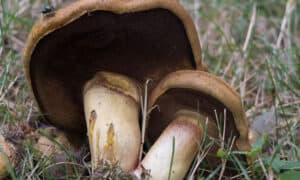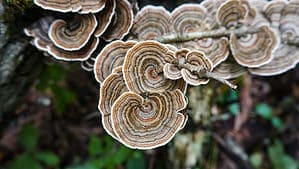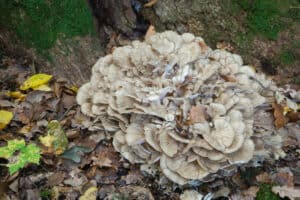Various species of jack-o’-lantern mushrooms and chicken of the woods commonly occur across North American forests, sometimes with overlapping fruiting periods. These mushrooms don’t resemble each other enough to be lookalikes, although young specimens of both species groups commonly feature bright orange-yellow coloration.
In this guide, we’ll discuss six key differences between jack-o’-lantern mushrooms vs. chicken of the woods, delving into their fungal classification, morphologies, ecological roles, and edibility statuses.
Read on to learn more.
Jack-o’-Lantern Mushroom vs. Chicken of the Woods: Fungal Classification
The jack-o’-lantern mushroom refers to several vibrantly orange and bioluminescent species in the Omphalotus genus that occur across North America, East Asia, and Europe. In North America, these species include Omphalorus illudens, O. olivascens, and O. subilludens. This spooky genus belongs to the Omphalotaceae family in the Agaricales order.
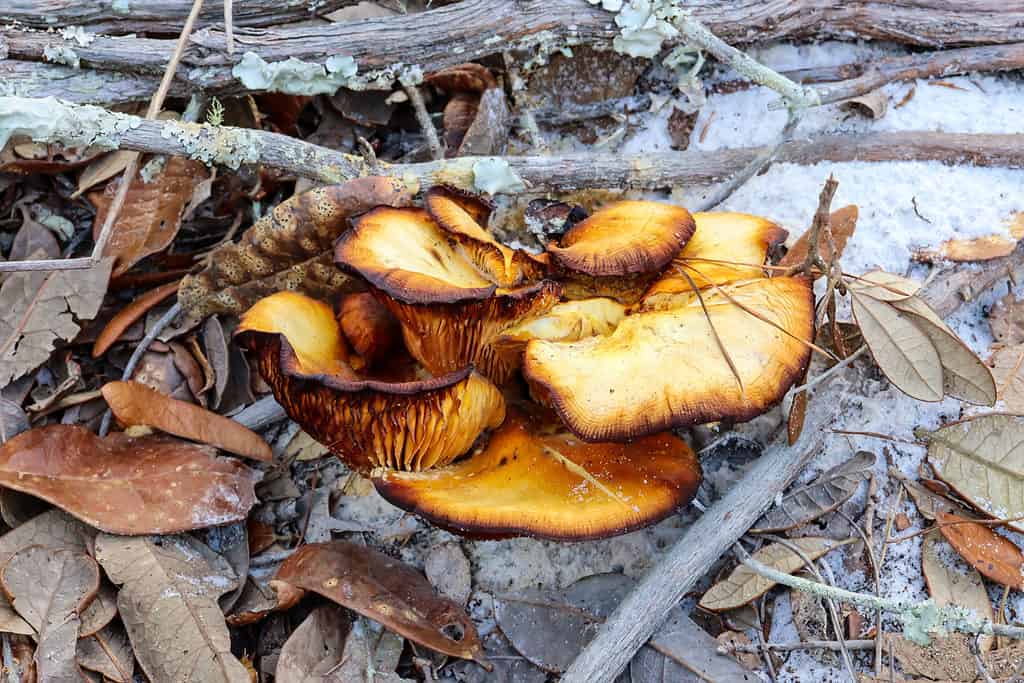
An aged Southern Jack O’Lantern mushroom cluster (Omphalotus subilludens).
©John_P_Anderson/Shutterstock.com
Chicken of the woods is the common name for a number of edible polypore mushrooms of the Laetiporus genus. These typically brightly-colored mushrooms are widely distributed across East Asia, Southern Africa, Europe, the Americas and Caribbean Islands, and Australasia. In North America, identified species include Laetiporus sulphureus, L. conifericola, L. gilbertsonii, L. persicinus, L. cincinnatus, and L. huroniensis. This genus belongs to the Fomitopsideaceae family of the Polyporales order.
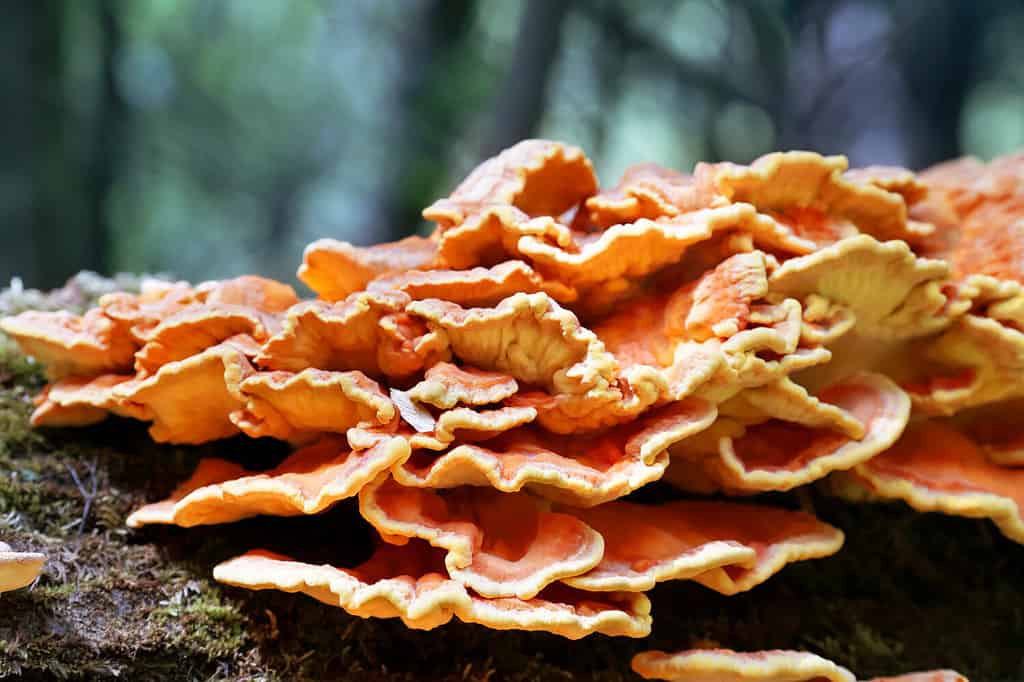
The pores of
Laetiporuslook quite different than the gills of
Omphalotus.
©Ksenia Lada/Shutterstock.com
Jack-o’-Lantern Mushroom vs. Chicken of the Woods: Morphology
While the majority of jack-o’-lantern and chicken of the woods species feature bright orange coloration, that’s about where the morphological similarities end.
Morphology of Jack-o’-Lantern Mushrooms
Jack-o’-lantern mushrooms, especially when young, are quite distinct and eye-catching in appearance.
Color
When young and fresh, jack-o’-lantern mushrooms typically feature clusters of bright orange fruiting bodies. Most species feature pale orange flesh. Typically, the cap is the most vividly orange colored. Underneath the cap, you will find pale orange gills (never pores) and a pale yellow-orange stipe.
Cap
The morphology of jack-o’-lantern mushrooms is slightly different depending on the species. Immature specimens of Omphalotus illudens, for example, have convex caps with a central bump and in-rolled margins. As the mushroom grows, the cap expands into a disc or slight vase shape with a central depression and upturned margins. The cap may reach up to about 8 inches across. The spore print is cream to pale yellow.
Omphalotus olearius‘s cap, in contrast, does not typically feature a central bump and grows up to only 5 inches in diameter. Mature specimens of this species often have caps that turn brown with age. The spore print is whitish.
Gills
Jack-o’-lantern mushrooms have a well-defined cap and stipe (stem) structure with gills that run partially down the length of the stipe (decurrent). At night, the gills of fresh specimens can glow a faint pale green. The gills tend to be crowded or close and often feature instances of short gills, which don’t run all the way to the joining of the cap to the stipe.
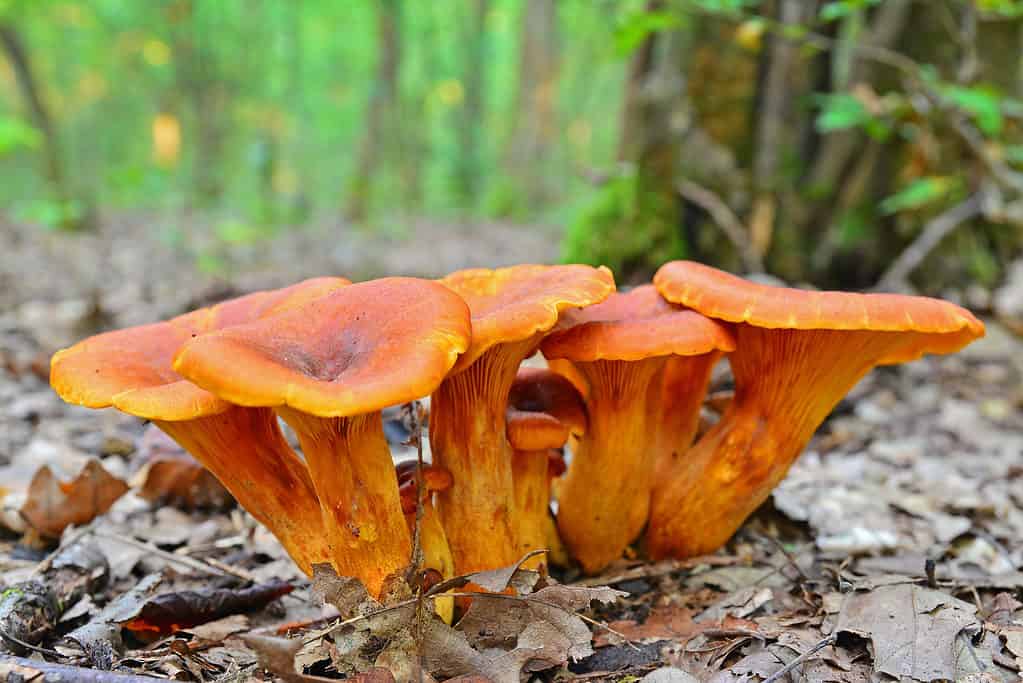
is shown growing from the roots of a tree.
©bogdan ionescu/Shutterstock.com
Morphology of Chicken of the Woods
The morphology of chicken of the woods varies slightly across species, especially in regards to cap shape, color vibrancy of the fruiting body, spore print, and pore color.
Color
While the hues vary, the fruiting bodies typically feature shades of orange, yellow, pinkish, and cream.
Pores
Unlike the gilled jack-o’-lantern mushrooms, the underside of chicken of the woods is covered in pores. These pores may be circular to angular in shape, range from white to yellow in color, and typically feature pore tubes that measure up to 5 millimeters deep.
Fruiting Body
The fruiting body typically consists of layers of densely clustered caps. The caps are generally thick and fleshed with a ruffled, fan, kidney, or semicircular shape. Depending on the species, individual caps may reach up to 10 inches across, while the entire fruiting body can measure up to 3 feet in diameter. One of the most common eastern North American species is Laetiporus sulphureus. When fresh and young, it displays caps with bright orange centers and yellow along the margins. With age, the fruiting body becomes a pale cream-yellow or dull orange. The caps are fan-shaped, semicircular, or irregular in shape. They form in lateral shelf-like layers. The pore surface is vividly yellow and dulls with age. On this species, there are 2-4 pores per millimeter, with pore tubes measuring up to 5 millimeters deep.
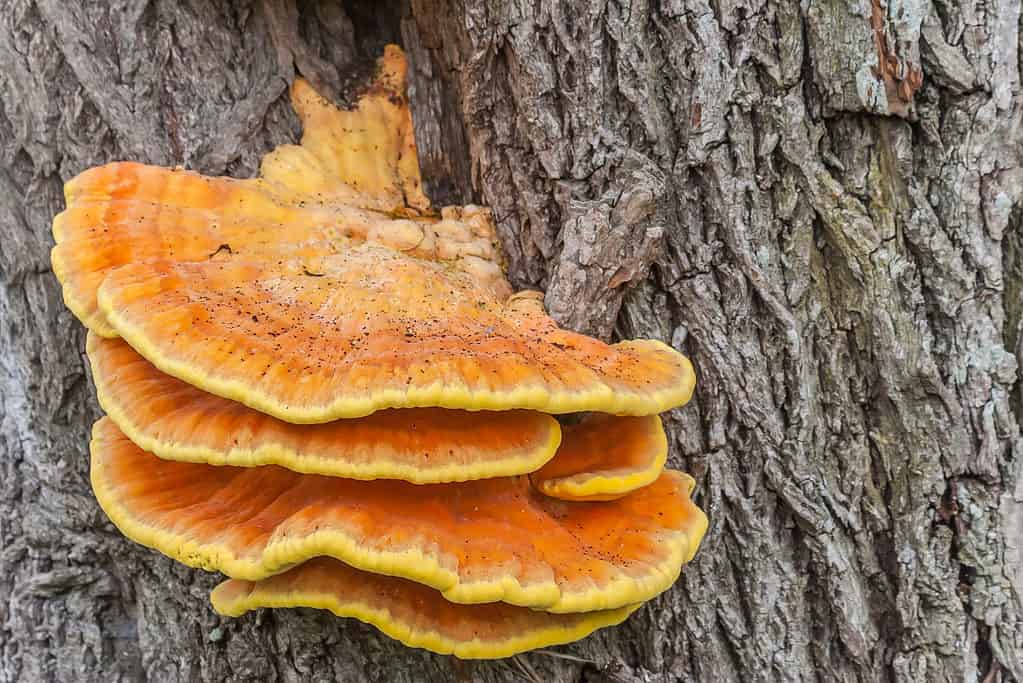
, aka chicken of the woods mushroom, grows on the side of a tree.
©Marc Venema/Shutterstock.com
Jack-o’-Lantern Mushrooms vs. Chicken of the Woods: Ecology
The ecological roles of jack-o’-lantern mushrooms and chicken of the woods are quite distinct from each other. While neither engages in a mutually beneficial nutrient exchange with the roots of plants (mycorrhizal), chicken of the woods is parasitic and saprobic, while jack-o’-lantern mushrooms are strictly saprobic.
Ecology of Jack-o’-Lantern Mushrooms
All species in the Omphalotus genus are saprobic, meaning they derive their nutrients by decomposing organic matter. As decomposers, jack-o’-lantern mushrooms contribute to vital nutrient recycling and carbon sequestration. Omphalotus species are white-rot fungi, meaning they are capable of breaking down lignin in wood, leaving white, fibrous wood residue. They also break down cellulose and hemicellulose.
Jack-o’-lantern mushrooms most frequently fruit in large clusters on rotting hardwood stumps. They may also appear to fruit from the soil, but as wood-decayers, these mushrooms are actually growing from buried rotting wood or roots—most species fruit from late summer through fall.
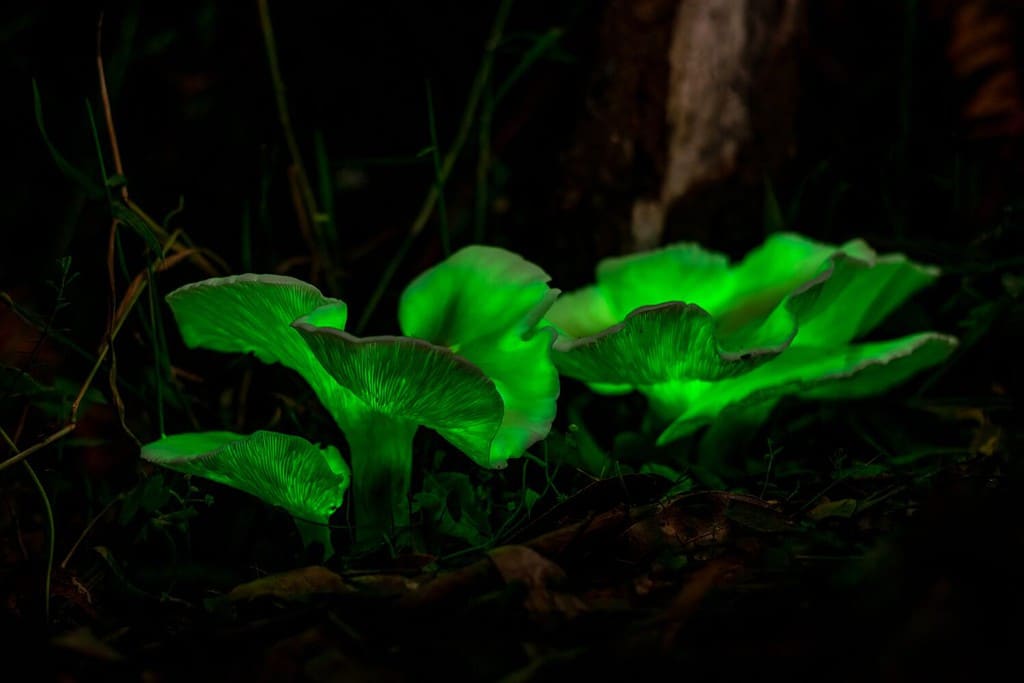
Jack’s glow is caught by a slow shutter speed camera.
©Petar B photography/Shutterstock.com
Ecology of Chicken of the Woods
All Laetiporus species are both parasitic and saprobic. These mushrooms are brown-rot fungi, capable of degrading the carbohydrates cellulose and hemicellulose but not lignin. Depending on the species, they may cause a brown rot at the base of trees, on the roots, or on the heart of the tree. Parasitic mushrooms like chicken of the woods contribute to the long-term health and biodiversity of forests by making room for new and healthy plant growth and by returning nutrients to the soil.
Laetiporus sulphureus causes a brown heart rot primarily on living oak trees. It will continue to decompose the tree after it has died. This species primarily fruits in summer and fall, although it may also grow in early spring and winter in warmer locations. L. sulphureus occurs widely east of the Rocky Mountains and in Europe.
Laetiporus cincinnatus, in contrast, causes a brown rot at the base and roots of oaks and fruits from late spring through fall. L. cincinnatus occurs widely east of the Great Plains.
Laetiporus conifericola is an example of a species that grows on coniferous trees and is widely distributed west of the Rocky Mountains. This species primarily fruits at the base of living and dead fir, spruce, and hemlock trees.
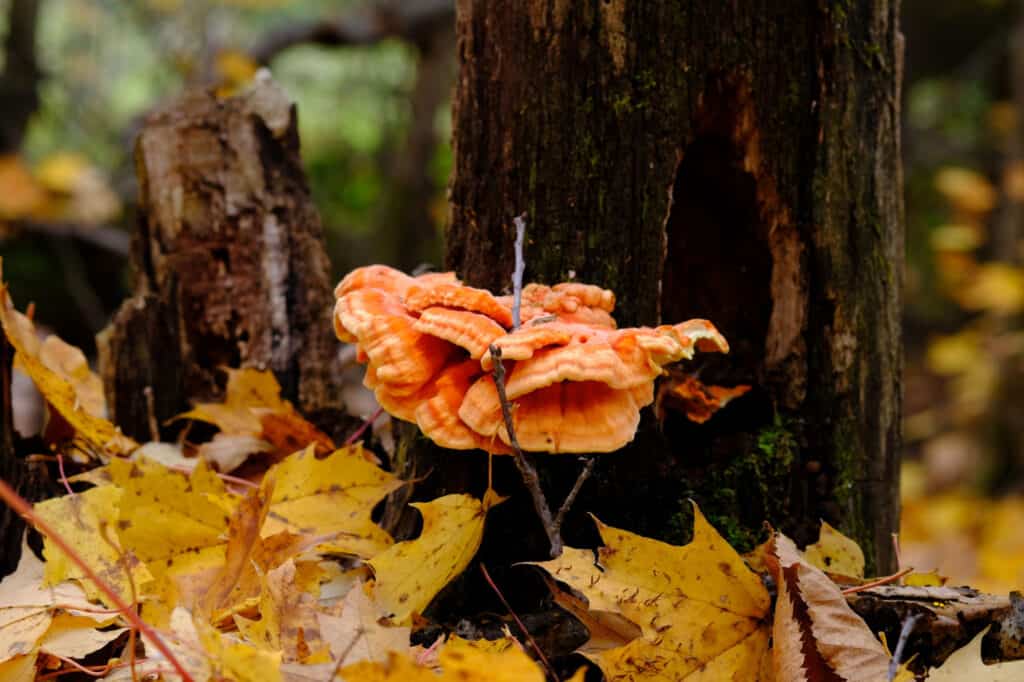
Very few mushroom species look like the chicken of the woods mushroom.
©nomis_h/Shutterstock.com
Jack-o’-Lantern Mushrooms vs. Chicken of the Woods: Edibility
Regarding edibility, jack-o’-lantern mushrooms and chicken of the woods are quite opposing.
Edibility of Jack-o’-Lantern Mushrooms
Foragers often learn about the toxic jack-o’-lantern mushroom due to their similar morphology to some species of the highly prized chanterelles (Cantharellus spp.). Many species in the Omphalotus genus contain a toxin called illuden S, which causes severe gastrointestinal symptoms in humans when ingested. These symptoms typically appear 1-2.5 hours after ingestion of the raw or cooked mushroom.
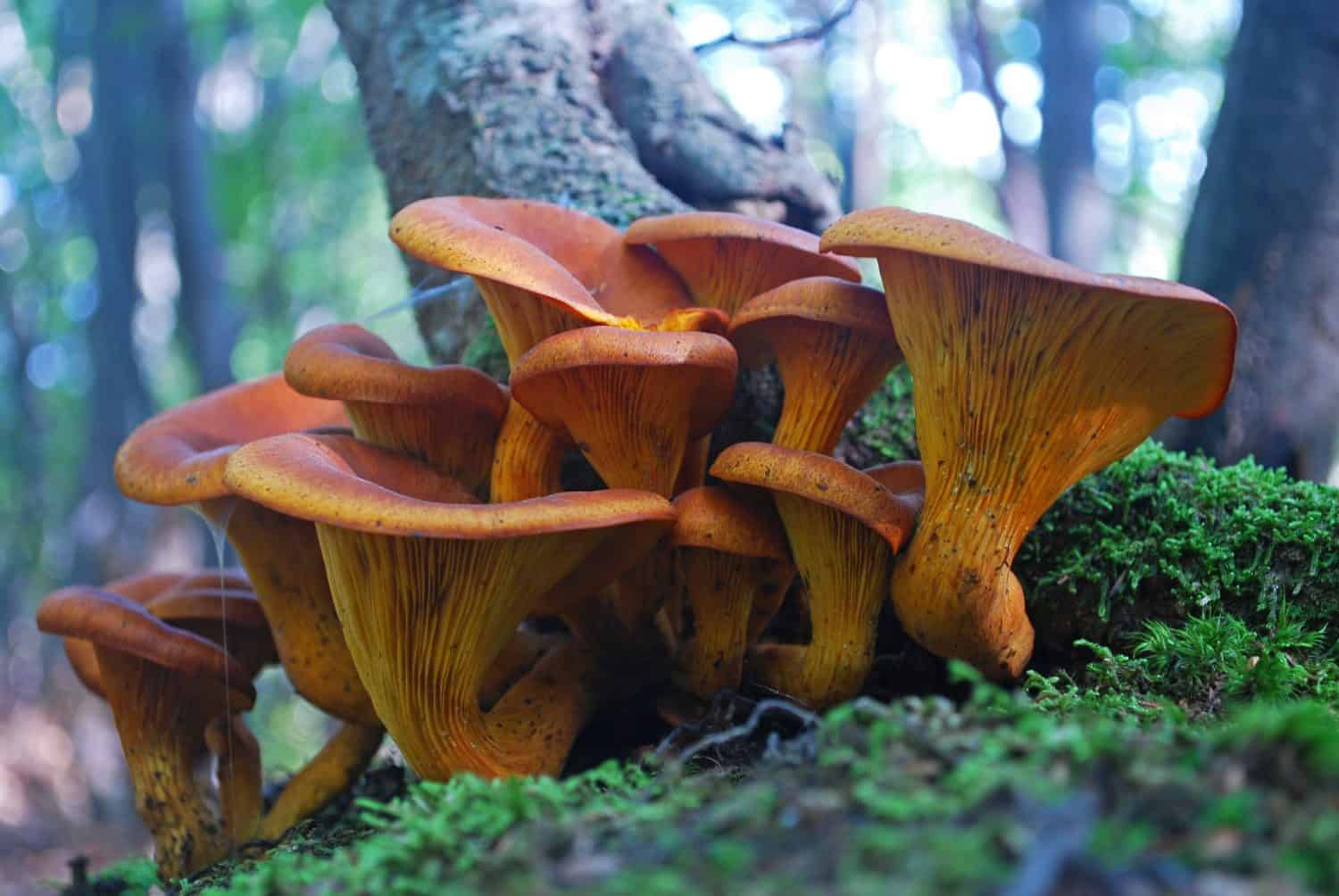
Eating these probably won’t kill you, but it will not be a pleasant experience.
©Ivan Marjanovic/Shutterstock.com
Edibility of Chicken of the Woods
In contrast, chicken of the woods is a quite delicious edible mushroom, although some people do experience gastrointestinal upset after consumption. This appears to primarily occur if someone eats a particularly aged specimen or if they do not thoroughly cook the mushroom. As such, most field guides recommend only harvesting young and fresh specimens and thoroughly cooking the mushrooms for at least 15 minutes before eating. As a general rule of thumb, it’s best to only initially eat a small amount of a new-to-you edible wild mushroom and wait 24 hours to assess for gastrointestinal upset before consuming more.
The common name “chicken of the woods” refers to the taste and texture of the mushroom. Fresh, young specimens have a juicy, meaty, and slightly fibrous texture and savory, mildly lemony, and chicken-like flavor profile. As such, chicken of the woods mushrooms make excellent meat alternatives in a range of dishes. They are delicious breaded and fried, baked, grilled, and sauteed.
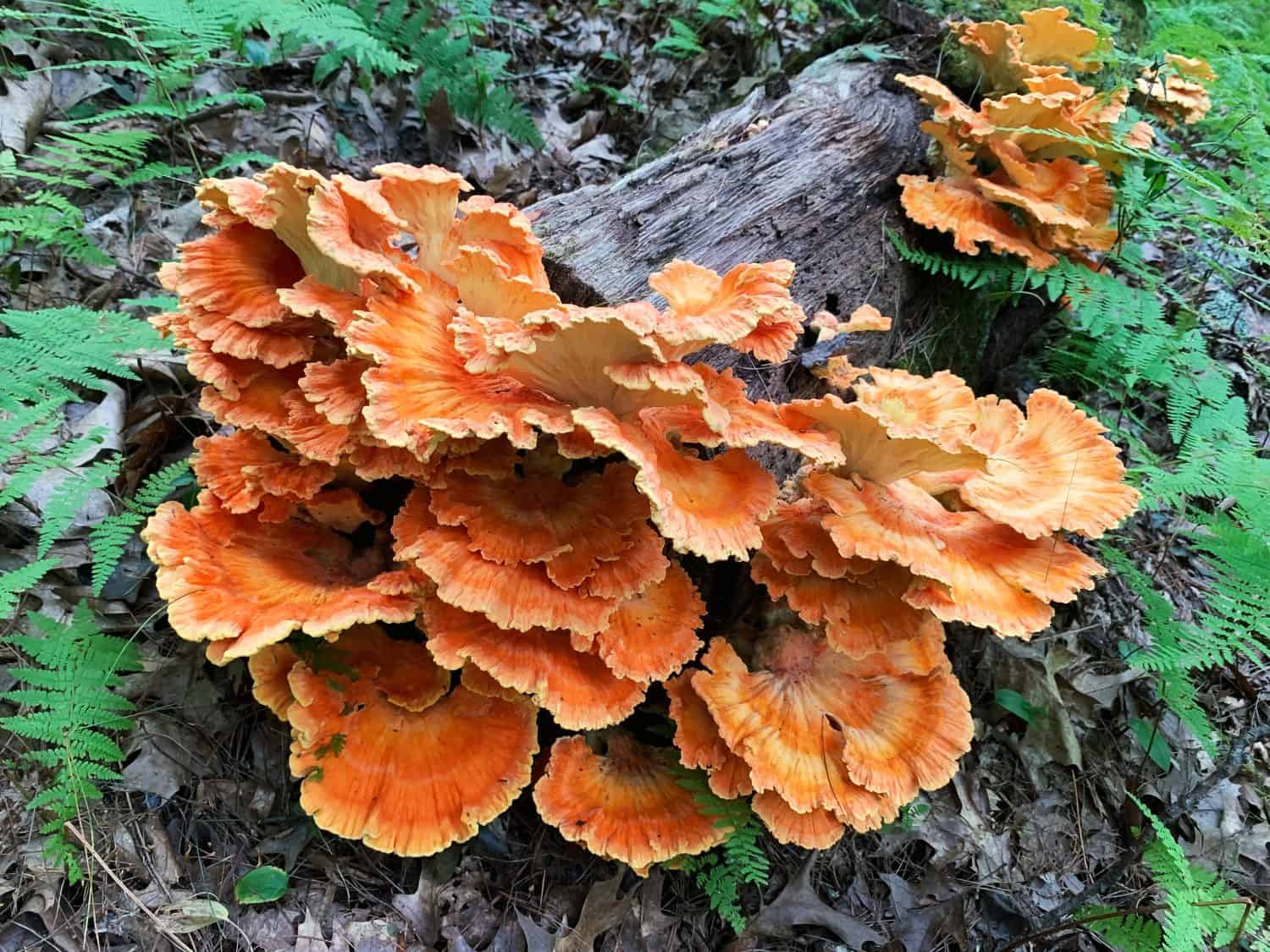
Chicken of the Woods is a prized edible that is relatively easy to ID and, luckily, comes in large quantities.
©MW ADK/Shutterstock.com
The photo featured at the top of this post is © MW ADK/Shutterstock.com
The information presented on or through the Website is made available solely for general informational purposes. We do not warrant the accuracy, completeness, or usefulness of this information. Any reliance you place on such information is strictly at your own risk. We disclaim all liability and responsibility arising from any reliance placed on such materials by you or any other visitor to the Website, or by anyone who may be informed of any of its contents. None of the statements or claims on the Website should be taken as medical advice, health advice, or as confirmation that a plant, fungus, or other item is safe for consumption or will provide any health benefits. Anyone considering the health benefits of particular plant, fungus, or other item should first consult with a doctor or other medical professional. The statements made within this Website have not been evaluated by the Food and Drug Administration. These statements are not intended to diagnose, treat, cure or prevent any disease.
Thank you for reading! Have some feedback for us? Contact the AZ Animals editorial team.




